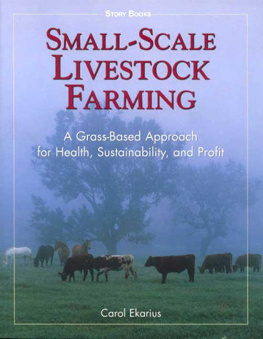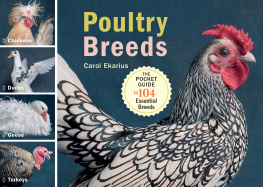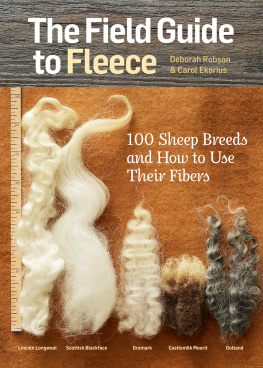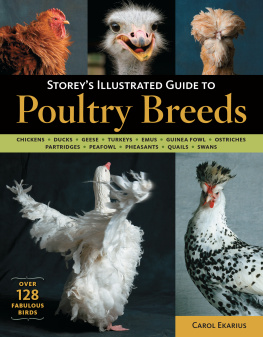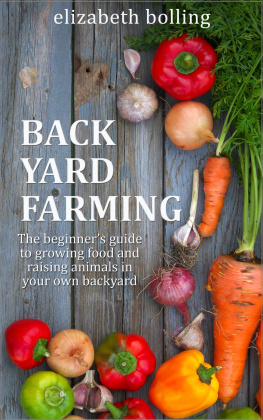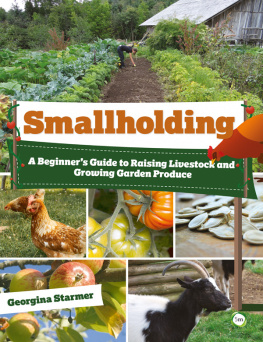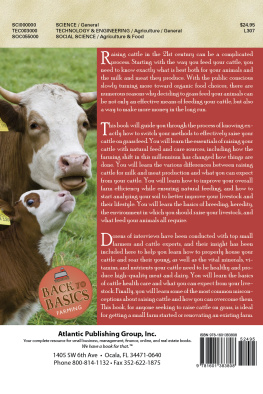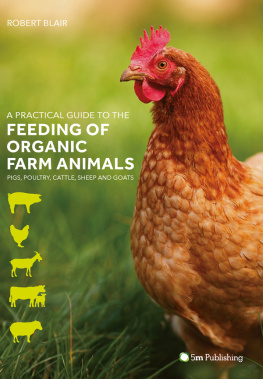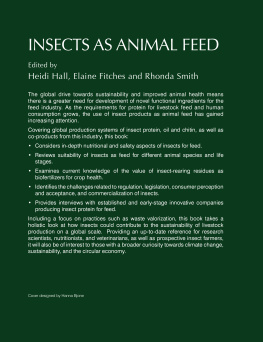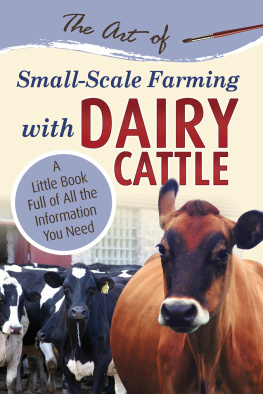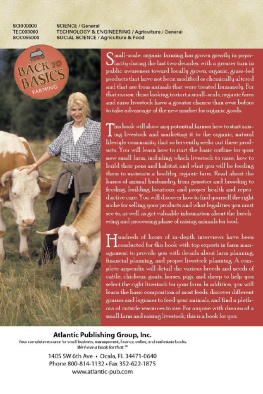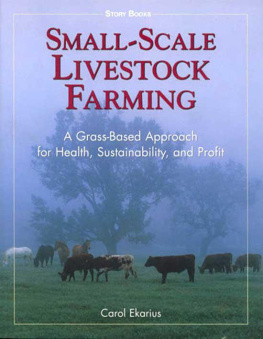S MALL -S CALE L IVESTOCK F ARMING
A Grass-Based Approach for Health, Sustainability, and Profit
Carol Ekarius 

In Memory of
D OUG S PEAR
February 21, 1957, to February 2, 1999
A great friend, a craftsman and artisan, a chicken fancier, and a person who taught us a lot about sustainability. His flame will burn on, in the hearts of his family and friends.
We miss you, Doug.
The mission of Storey Publishing is to serve our customers by publishing practical information that encourages personal independence in harmony with the environment.
Edited by Marie Salter and Laura Jorstad
Cover design by Meredith Maker
Cover photograph Grant Heilman/Grant Heilman Photography, Inc.
Text design and production by Erin Lincourt
Line drawings on pp. 131133 by Bethany Caskey; on p. 193 by Jeffrey C. Domm; on pp. 3, 4, 10, 12 (top), 13, 14, 16, 24, 29, 30, 61, 66, 73, 76 (top), 77, 85, 139, 150, 161, 162, 173, 175, 179 by Chuck Galey; on p. 193 by Carol Jessop; on pp. 8, 9, 11, 12 (bottom), 20, 21, 27, 28, 31, 35, 37, 38, 43, 44, 48, 51, 56, 57, 62, 64, 65, 70, 74, 76, 78, 82, 83, 95, 129, 163, 191, 199 by Elayne Sears; and on p. 197 by Becky Turner.
Indexed by Susan Olason/Indexes & Knowledge Maps
1999 by Carol Ekarius
All rights reserved. No part of this book may be reproduced without written permission from the publisher, except by a reviewer who may quote brief passages or reproduce illustrations in a review with appropriate credits; nor may any part of this book be reproduced, stored in a retrieval system, or transmitted in any form or by any means electronic, mechanical, photocopying, recording, or other without written permission from the publisher.
The information in this book is true and complete to the best of our knowledge. All recommendations are made without guarantee on the part of the author or Storey Publishing. The author and publisher disclaim any liability in connection with the use of this information. For additional information, please contact Storey Publishing, 210 MASS MoCA Way, North Adams, MA 01247.
Storey books are available for special premium and promotional uses and for customized editions. For further information, please call 1-800-793-9396.
Printed in the United States by Versa Press
20 19 18 17 16 15 14 13 12
Library of Congress Cataloging-in-Publication Data
Ekarius, Carol.
Small-scale livestock farming : a grass-based approach for health, sustainability, and profit / Carol Ekarius.
p. cm.
ISBN-13: 978-1-58017-162-5
1. Livestock. 2. LivestockMarketing. 3. Farm management. I. Title
SF61.E465 1999
636dc21 99-29586
CIP
Contents

Preface
While we have land to labor, then, let us never wish to see our citizens occupied at a work-bench, or twirling a distaff. Carpenters, masons, smiths are wanting in husbandry: but, for the general operations of manufacture, let our workshops remain in Europe.... The loss by the transportation of commodities across the Atlantic will be made up in happiness and permanence of government. The mobs of great cities add just so much to the support of pure government, as sores do the strength of the human body.
Cultivators of the earth are the most valuable citizens. They are the most vigorous, the most independent, the most virtuous, and they are tied to their country, and wedded to its liberty and interests by the most lasting bonds.
Thomas Jefferson

S OMETIME AROUND 1983, my husband, Ken Woodard, and I were living in a ski-resort town in the Colorado Rockies and were mulling over the idea of moving to the country. We were at least a couple of generations removed from the farm and had no experience with farming or rural living, but we sure were intent on the idea.
Magazines like the Small Farmers Journal and The New Farm were part of our regular mail; we devoured books on gardening, farming, livestock raising, and general rural living. We were preparing for our first attempt at country living.
How We Got Here
In 1984, we moved to 40 acres (16.2 ha) out of town. We bought horses. We bought ducks, geese, and chickens. We bought an orphaned calf from a local rancher. We almost killed that calf with kindness; overfeeding brought on scours, but luckily Kens grandfather was still alive to render a fast diagnosis and recommend a treatment regimen for us. Little Fat Girl grew into a nice-size heifer.
We moved to an 80-acre (32.4-ha) commercial farming operation in Minnesota in 1989, and husbandry became our vocation as well as our avocation. The farm consisted of 53 acres (21.5 ha) of tillable ground; the remainder was in permanent pasture with a stream running through it and a pond at one end. It was in a traditional dairy area and was set up with a dairy barn, a three-sided equipment/hay shed, and some old, falling-down sheds. The soil was moderately fertile.
For as many years as the neighbors could remember (and their collective memories went back a very long time), the tillable ground had been in monocropped corn, primarily harvested as silage to feed the dairy herd. The permanent pasture became little more than a weed-choked exercise area in summer. The creek bottom was severely pugged by years of cattle hooves, and the stream had become more intermittent over the years, holding water for shorter periods of time regardless of precipitation. Fish had become nonexistent in the stream. The hillsides had large washout areas and little remaining topsoil.
During the decade prior to our purchase, four families had come and gone, trying to make a go of milking cows using conventional techniques. Twenty-six cows spent most of their time stanchioned in the barn. The farmer brought their feed to them, primarily in the form of silage, supplemented by purchased hay and grain. Hauling manure out was a daily job. Fans ran continuously in summer to cool the barn, and the water lines to the barn routinely froze in winter. These families fell into the too big/too small conundrum. The economics of a confinement dairy could not support them, yet they worked too many hours per day to be able to seek off-farm work. They left, economically, spiritually, and physically broken. As each family passed on, the land was left a little more degraded.
When we gave up our jobs (good, secure jobs with benefits) to become full-time farmers, everyone thought we were crazy. Our families and friends wanted to know how we thought we could possibly make it when farmers whod been farming their whole lives were failing. They may still be dismayed with our choice, but they now acknowledge our success.
A ranch in Colorado was our first dream, but as we pursued it, we concluded that we couldnt afford full-time ranching. Colorado ranches were for rock stars and Rockefellers, so we made our move to Minnesota. During the nine years we farmed in Minnesota, we learned a lot about farming, marketing, and getting by on less. We came to believe we could get by on a small piece of land in the arid West. So in the fall of 1997, we sold the Minnesota farm, traveled through New Mexico and Arizona during the winter taking our first joint vacation in over a decade and returned to Colorado in the spring of 1998. We still arent rock stars or Rockefellers, so we own just a small piece of land and lease the additional acreage we need. Leasing allows us to not tie up too much of our capital on the land.

